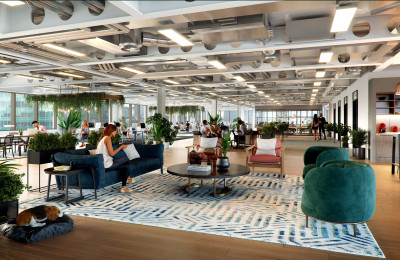Can we feel well in the office?
What does it take for a workplace to make people feel well? How should workplaces that support wellbeing be created and how can their efficiency be measured?
Today’s thinking suggests an individual plays a crucial role in their own happiness. And there are many precautions one can take to improve their daily working routine indeed. You can source some inspiration from our series of articles about personal wellbeing in the workplace.
But there’s much more truth to it when it comes to the organisational level. Why? Because people plan and create offices around their culture at the same time. That being said, it might sound easy in theory but how does it play out in reality?
At HB Reavis, we believe that every person has the right to modern workspace which should:
- Support personal development
- Reduce stress
- Have a positive impact on health
- Increase productivity
From a physical perspective, design is a key facet that stimulates people’s perception and has a direct impact on their overall satisfaction and culture every day. Rather than only being in accordance with the newest trends on the market, it should be people-centric and reflect their needs and preferences.
Only this way can it nurture the company’s culture and bring the best out of the people in it. And it takes much more than just skilled interior designers – sociologists, psychologists, architects, biophilic specialists, among many others, should contribute.
How to measure workplace activation?
Once the workspaces are ready and being used by employees, it is important to learn and explore what has been done correctly with the office design and what needs more attention. Finding gaps allows for adjustments that enable companies to reach their desired results. How can the degree to which workplace solutions support employees and organisational performance be measured?
In 2010, Leesman developed and introduced a standardised workplace experience evaluation tool for everyone involved in the management, design and delivery of corporate workspace. Over the years, they carried out a large and independent research study and put together a benchmark database of workplace experience data.
The Leesman Methodology
The evaluation of workplaces is based on a standardised online employee survey that allows for a quick and systematic approach to data collection that generates workplace experience KPI called Lmi. In addition, the results are compared against over 4,900+ of other workspaces and it is now recognised as the global standard measurement of employee workplace experience.
The Lmi is calculated from two out of four areas of enquiry from the Leesman Index analysis: Workplace Impact on elements such as pride, productivity, community, and Work Activities (which activities are important to an employee and how well they are supported). A score is given on a simple 0-100 scale.
Delos cooperation
Last but not least, Leesman was approached by Delos, the founder of the WELL Building Standard™, flexible certification that positions building design and operations as agents of public health. It measures, verifies and monitors building features that impact health, wellbeing and productivity.
In cooperation with Delos, they have created a WELL module in the survey comprised of 12 statements that investigate to what extent designed workspaces support wellbeing, for example, the design supporting wellbeing and performance or an access to adjusting the physical conditions.
Well Building Standard introduction video
All in all, office design is a crucial factor which must be taken into account when creating or changing workspaces in order to achieve productive and healthy environments for employees. Making a workplace a pleasant, safe space where people don’t mind spending time results in employee satisfaction, and that mirrors organisational performance.
To grasp the extent of its effect, the Leesman Index provides clear and direct metrics that help companies and designers to gain valuable insights about people’s satisfaction and use of designed workspaces.






